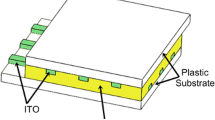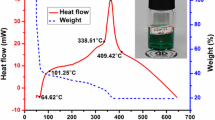Abstract
Organic devices promise to revolutionize the extent of, and access to, electronics by providing extremely inexpensive, lightweight and capable ubiquitous components that are printed onto plastic, glass or metal foils1,2,3. One key component of an electronic circuit that has thus far received surprisingly little attention is an organic electronic memory. Here we report an architecture for a write-once read-many-times (WORM) memory, based on the hybrid integration of an electrochromic polymer with a thin-film silicon diode deposited onto a flexible metal foil substrate. WORM memories are desirable for ultralow-cost permanent storage of digital images, eliminating the need for slow, bulky and expensive mechanical drives used in conventional magnetic and optical memories. Our results indicate that the hybrid organic/inorganic memory device is a reliable means for achieving rapid, large-scale archival data storage. The WORM memory pixel exploits a mechanism of current-controlled, thermally activated un-doping of a two-component electrochromic conducting polymer.




Similar content being viewed by others
References
Forrest, S. R., Burrows, P. E. & Thompson, M. E. Organic emitters promise a new generation of displays. Laser Focus World, Feb., 99–101 (1995)
Gelinck, G. H., Geuns, T. C. T. & Leeuw, D. M. d. High-performance all-polymer integrated circuits. Appl. Phys. Lett. 77, 1487–1489 (2000)
Peumans, P., Yakimov, A. & Forrest, S. R. Small molecular weight organic thin-film photodetectors and solar cells. J. Appl. Phys. 93, 3693–3723 (2003)
Saluel, D., Daval, J., Bechevet, B., Germain, C. & Valon, B. Ultra high density data storage on phase change materials with electrical micro-tips. J. Magn. Magn. Mater. 193, 488–491 (1999)
Asokan, S. Electrical switching in chalcogenide glasses—Some newer insights. J. Optoelectron. Adv. Mater. 3, 753–756 (2001)
Stocker, H. J. Bulk and thin film switching and memory effects in semiconducting chalcogenide glasses. Appl. Phys. Lett. 15, 55–57 (1969)
Hua, Z. Y., Chen, G. R., Xu, W. & Chen, D. Y. New organic bistable films for ultrafast electric memories. Appl. Surf. Sci. 169, 447–451 (2001)
Heuer, H. W., Wehrmann, R. & Kirchmeyer, S. Electrochromic window based on conducting poly (3,4-ethylenedioxythiophene)poly(styrene sulfonate). Adv. Funct. Mater. 12, 89–94 (2002)
Groenendaal, B. L., Jonas, F., Freitag, D., Pielartzik, H. & Reynolds, J. R. Poly(3,4-ethylenedioxythiophene) and its derivatives: Past, present, and future. Adv. Mater. 12, 481–494 (2000)
Hack, M. & Street, R. A. Analysis of double injection in amorphous silicon p-i-n diodes. J. Appl. Phys. 72, 2331–2339 (1992)
Johansson, T., Pettersson, L. A. A. & Inganas, O. Conductivity of de-doped poly(3,4-ethylenedioxythiophene). Synth. Met. 129, 269–274 (2002)
Greczynski, G. et al. Photoelectron spectroscopy of thin films of PEDOT-PSS conjugated polymer blend: a mini-review and some new results. J. Electron Spectrosc. Rel. Phenom. 121, 1–17 (2001)
Xing, K. Z., Fahlman, M., Chen, X. W., Inganas, O. & Salaneck, W. R. The electronic structure of poly(3,4-ethylene-dioxythiophene): Studied by XPS and UPS. Synth. Met. 89, 161–165 (1997)
Pei, Q. B., Zuccarello, G., Ahlskog, M. & Inganas, O. Electrochromic and highly stable poly(3,4- ethylenedioxythiophene) switches between opaque blue-black and transparent sky blue. Polymer 35, 1347–1351 (1994)
Acknowledgements
We thank A. Elschner and H. C. Starck for samples of Baytron P, and M. Thompson for discussions. We also thank National Renewable Energy Laboratories for supplying the thin-film Si diodes. This work was supported by HP and the National Science Foundation.
Author information
Authors and Affiliations
Corresponding author
Ethics declarations
Competing interests
The authors declare that they have no competing financial interests.
Rights and permissions
About this article
Cite this article
Möller, S., Perlov, C., Jackson, W. et al. A polymer/semiconductor write-once read-many-times memory. Nature 426, 166–169 (2003). https://doi.org/10.1038/nature02070
Received:
Accepted:
Issue Date:
DOI: https://doi.org/10.1038/nature02070
- Springer Nature Limited
This article is cited by
-
Study of current conduction mechanism and resistive switching stability in the PVdF-HFP-based memristor
Journal of Materials Science: Materials in Electronics (2023)
-
An Account of Natural Material-Based Nonvolatile Memory Device
Proceedings of the National Academy of Sciences, India Section A: Physical Sciences (2023)
-
Synaptic plasticity in electro-polymerized PEDOT based memristors for neuromorphic application
Journal of Materials Science: Materials in Electronics (2022)
-
Temperature induced low voltage write-once-read-many resistive switching in Ag/BTO/Ag thin films
Journal of Materials Science: Materials in Electronics (2022)
-
Gold nanoparticles functionalized with 4,4’-dithiobiphenyl blended with CuS in PMMA for switching memory devices
Journal of Materials Science: Materials in Electronics (2020)





